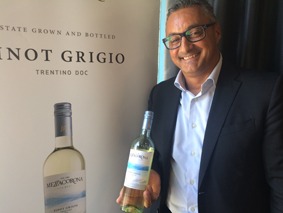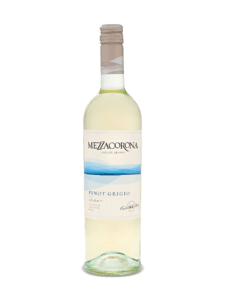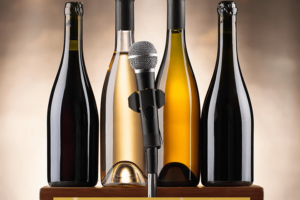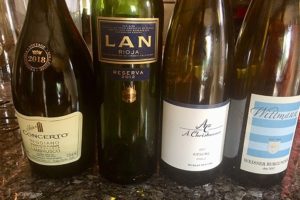 Waiting for a special room to be set up for 12 guests of Woodman Wine & Spirits at Little Anthony’s Italian Ristorante in Toronto, I found myself seated at the bar with the guest of honour, Lucio Matricardi, head winemaker for the co-op-owned winery trio of Mezzacorona and Rotari in Northern Italy and Stemmari in Sicily.
Waiting for a special room to be set up for 12 guests of Woodman Wine & Spirits at Little Anthony’s Italian Ristorante in Toronto, I found myself seated at the bar with the guest of honour, Lucio Matricardi, head winemaker for the co-op-owned winery trio of Mezzacorona and Rotari in Northern Italy and Stemmari in Sicily.
Trained in winemaking and viticulture at the University of Bologna, Matricardi began his career in agricultural research and was instrumental in designing the modern vineyard architecture needed in Sicily to optimize growing in the unique Mediterranean climate. He also earned his Ph.D. in viticulture and enology from the University of California at Davis, with a focus on barrique and oak aging. He has worked at wineries around the globe, mastering wines from Brunello at Castello Banfi in Tuscany to Shiraz at Miranda winery in South Australia.
But it’s Matricardi’s primary office in Trentino, Italy that truly impresses. An under-appreciated wine region the foot of the Dolomites, at the southern edge of the Alps, bordering Austria and Switzerland, Trentino is almost computer-generated in its raw, spellbinding beauty. “When you pick the grapes, you can see downhill skiers in the distance,” Matricardi enthuses.
With vineyards working their way from the valley floor up the slopes of surrounding mountains that soar to 9,000 feet, there’s no shortage of cool growing conditions for Mezzacorona’s still wines and Rotari’s traditionally styled bubbly. That mountain climate means the acidity is preserved and minerality abundant in the finished products. A near-constant wind adds an extra layer in protecting the health of Matricardi’s vines.
While the climate might restrict the size of the crop, sugar is nevertheless concentrated. And Matricardi and his team add to the equation with something he says is rare in the Pinot Grigio world: They pick the grapes when they’re ripe!
“Everyone produces Pinot Grigio and then the price goes down,” Matricardi laments. “In many cases, once it became a commodity, it started to lose its authenticity and its (link to its region). If you grab a bottle off the shelf and look at the back label, most of the time you can’t figure out who is the mother or who is the father. I call those bottles ‘orphan wines’—wines made by businesspeople: ‘It means money, so let’s bottle it!’ But in five years, if milk is a better business, those people will switch to milk! It’s a tool to make money, not a tool to tell a story. For us, the wine is a story, it’s a book.”
 The passionate Matricardi believes Pinot Grigio’s popularity has ironically also been its curse, with too much mass production and, in many cases, less attention to detail and terroir. “People have been told to think that Pinot Grigio is an aperitif,” he says. “There’s a lot of Pinot Grigio coming from some areas that’s made (purposefully) light, watery, easy-drinking. But that’s only 50% of what Pinot Grigio can be.
The passionate Matricardi believes Pinot Grigio’s popularity has ironically also been its curse, with too much mass production and, in many cases, less attention to detail and terroir. “People have been told to think that Pinot Grigio is an aperitif,” he says. “There’s a lot of Pinot Grigio coming from some areas that’s made (purposefully) light, watery, easy-drinking. But that’s only 50% of what Pinot Grigio can be.
“I tell you, 70% of Pinot Grigio on the market is harvested before it completely ripens,” Matricardi declares. “There’s a specific reason for that. The name Pinot Grigio comes from the word pinecone, because they grow in such small, tight clusters—not a loose bunch like Chardonnay. So most of the time, if you get a September rain, these berries push against each other and can explode. So in Veneto, you have to decide whether to pick or not based on the percentage of spoiled bunches—even though they’re not yet ripe. But in Trentino, the skins are thicker, so even if the berries push against each other, they don’t explode as easily. So it’s easier to let the grapes ripen another two weeks—when you start to get the stone fruit aromas like pear, peach and nectarine coming out. But every night is still a nightmare for us, waiting those last few days for the grapes to properly ripen. What happens if it rains tonight? But the acidity will still be there at the end. And the Pinot Grigio will show what it can be—what is in its DNA.”
How serious can this white wine be in all its glory? “I have a steak in Italy with Pinot Grigio!” says Matricardi,
Here’s a quick look at three of Mezzacorona’s Pinot Grigio’s—all well-priced for their quality.
 Mezzacorona Pinot Grigio 2018 – Trentino, Italy ($14.95)
Mezzacorona Pinot Grigio 2018 – Trentino, Italy ($14.95)
Looking for a safe and universally appealing Pinot for your summer party? This LCBO general-list offering features a nice mineral base with a deft balance of acidity, soft citrus, wildflowers and Granny Smith apple. Good value here. 87.5

Mezzacorona Riserva Pinot Grigio 2017 – Trentino, Italy ($17.95) (Vintages in January 11, 2020)
Pale gold in colour, 40% of this Pinot is fermented in stainless steel, with the remaining 60% in small oak barrels. After fermentation the wine remains in oak barrels for an additional 6-8 months. As Matricardi notes, there’s peach and chamomile there, but there’s also an intriguing lemon butter, not to mention a plush texture that should provide some food-pairing flexibility. Great value. You’ll just have to wait until January to get it at the LCBO when it hits Vintages shelves. 89

Mezzacorona Castel Firmian Pinot Grigio 2018 – Trentino, Italy ($16.95) (Vintages in January, 2020)
Straw yellow with green flecks, a stainless steel fermentation from the winery’s best grapes assures a rich, rounded, crisp Pinot Grigio with distinct notes of white stone fruits, albeit one that’s mineral-driven. This is Matricardi’s favourite of the trio—he loves its sense of place and purity—although I personally prefer the depth and more complex palate of the Riserva. But still very good stuff! 88.5




Leave a Reply
Your email is safe with us.